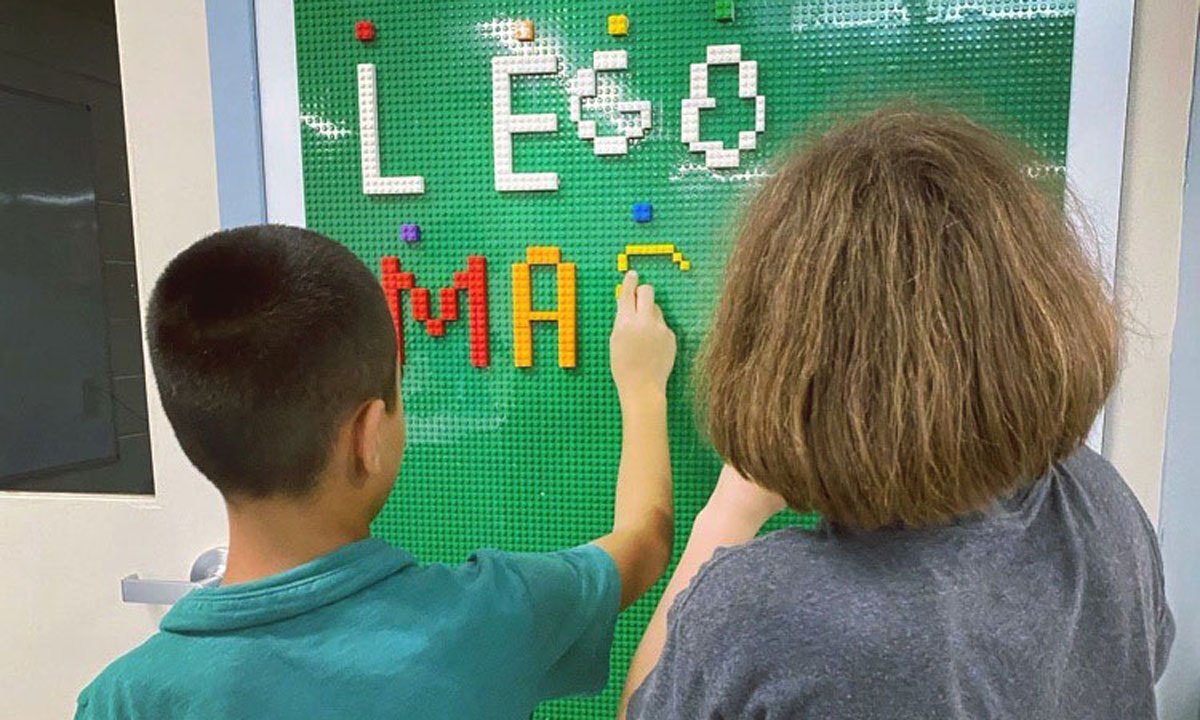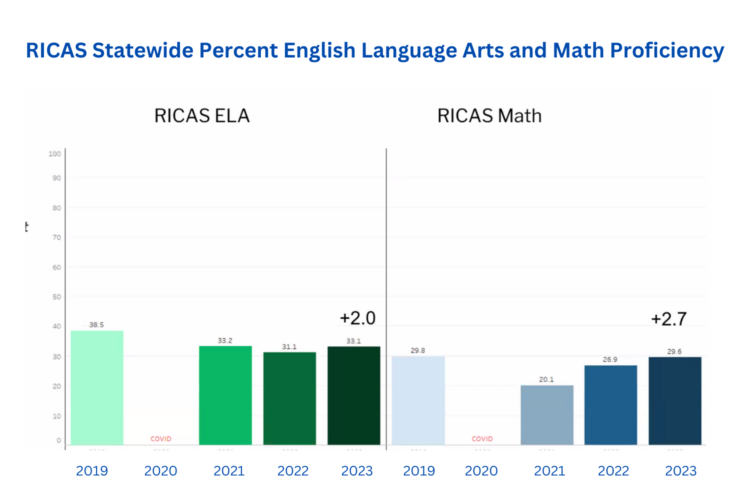Test Scores Show Rhode Island Students Still Recovering to Pre-Pandemic Levels
New scores show modest gains in reversing pandemic declines for math and English Language Arts proficiency last year.

Get stories like these delivered straight to your inbox. Sign up for The 74 Newsletter
New standardized test scores for Rhode Island students in grades 3 through 8 made public Wednesday show modest gains in reversing pandemic declines for math and English Language Arts (ELA) proficiency last year.
But improvement at the elementary and middle school levels on the 2023 Rhode Island Comprehensive Assessment System (RICAS) was tempered by PSAT and SAT results for grades 10 and 11 respectively. Nearly half of students taking the SAT last spring met expectations for high school ELA, but slightly more than 25% demonstrated proficiency in math.
That said, Education Commissioner Angélica Infante-Green still saw cause for celebration in shrinking the gap between the lagging test scores of Rhode Island students with their counterparts in Massachusetts — which leads the nation in math and reading. Since 2018, the performance gap has shrunk from 21% in math to 11% and from 17% to 9% in ELA, according to the new data from the Rhode Island Department of Education (RIDE).

“This is the closest we have ever been as a state. That’s pretty amazing,” Infante-Green said during a virtual presentation to share results with reporters Tuesday morning after holding sessions earlier and the previous day with groups of school superintendents.
The data was reviewed by Gov. Dan McKee last Friday. In a statement, McKee said the 2023 RICAS results show Rhode Island schools moving in the right direction to meet his goal of meeting or surpassing Massachusetts’ performance by the year 2030.
“Our students can perform at high levels, and we must stay the course and make sure our school communities have the support and resources to thrive,” McKee said.
A 2022 analysis by the National Center for the Improvement of Educational Assessment suggested it would take three to five years of accelerated learning for student achievement to return to what it was pre-pandemic. To at least match Massachusetts on test scores, McKee has launched his Learn 365 Initiative, which has distributed nearly $3.8 million to communities that signed compacts committing to creating out-of-school learning opportunities. RIDE was scheduled to hold sessions with city and town officials to review test scores on Wednesday.
The state saw a second year of significant growth in math proficiency with an approximate 2.7 percentage point increase this year, and an increase in English Language Arts (ELA) of approximately 2%.
Among all grades taking the RICAS, fourth graders saw the highest increase in proficiency in both math (from 30.2% to 36.0%) and ELA ( 29.0% to 33.3%)
Fifth grade math proficiency went from 25.9% to 30.0%. Math scores dropped for third graders by half a percentage point to 34.5%
Seventh graders saw a 0.2% drop in ELA proficiency to 29.0%.
Across all racial and ethnic groups, ELA scores increased over last year. In math, all but one racial and ethnic subgroup performed higher. The exception was the Native Hawaiian or other Pacific Islanders subgroup which dropped one percentage point, a small demographic of only 93 students, of 0.16% of the 59,272 third through eighth graders tested, Infante-Green said.

Participation rises, high school math scores fall
Increasing the number of students taking the PSAT and the SAT every April is considered the first step toward ensuring more students are college and career ready.
A total of 9,430 11th graders across the state took the SAT for mathematics, or 94.1%, up from 91.9% in 2022. The lowest rates of participation were at Providence’s Mount Pleasant (81.9%) and Central (82.1%) high schools and Woonsocket High School (82.5%)
The percentage of high school students meeting or exceeding expectations in math on the SAT remained flat statewide at 25.3% while those not meeting expectations increased 1% to 38.5%. In 2022, 30.8% of 11th graders did not meet expectations for math.
A total of 9,384 high school juniors, representing 94.4% of the state’s 11th graders, took the SAT for ELA/Literacy, up from 92.3% in 2022. The new results show 49.1% met or exceeded expectations, up from 47.1%, while 29.1% of students did not meet expectations, down from 30.8% in 2022.
The percentage of high school sophomores taking the PSAT increased over the past year from 90.5% to 92.4% in math and 91.1% to 92.9% in ELA. Statewide math scores dropped from 29.2% proficient in 2022 to 27.2% proficient this year. Statewide ELA results show 55.3% of students met or exceeded expectations, a drop from 59.2% proficient in 2022.
“Those were our kids that were in 8th grade when the pandemic started and we’re seeing that impact,” Infante Green said of high schoolers who had to struggle with the effects of lockdowns and social distancing during a pivotal year in their education and development. “It’s pretty consistent across the nation.”
Results showed a drop in the percentage of students in foster care taking the SAT, from 75.9% in 2022 to 71.8% in 2023, and from 80% to 76.4% who were homeless. The state saw a significant increase in American Indian and Alaskan Islander students taking the SAT, from 83.3% to 88.6%. More students with disabilities also took the SAT from 83.4% to 85.8%.
Multilingual learners
There was a 0.5% increase in multilingual students taking the ACCESS assessment, which tests students in four language domains: listening, reading, speaking, and writing. Student results are categorized in six levels: Entering, Emerging, Developing, Expanding, Bridging and Reaching. The percentage of students scoring at the Expanding and Bridging levels rose 0.3%.
Bright spots
Tiverton saw ELA proficiency rise significantly districtwide, a 10% increase to 47.3%. In Coventry, students proficient in ELA rose 5.2% to 39.2%.Significant gains in ELA proficiency were made at Providence’s Leviton Dual Language School, from 12.3% in 2022 to 29.6% this year; Richmond Elementary School from 49.4% to 66.5%; and Wyman Elementary School in Warwick, 24.7% to 41.7%.Math proficiency increased the most at West Kingston Elementary School in South Kingstown (20.7% to 47.3%); Norwood School in Warwick (18.0% to 38.5%) and Woodridge School in Cranston (31.9% to 48.9%).
RIDE will offer families Personalized Individual Student Reports that include individualized informational videos accessible through a QR code. The videos are available in 10 languages and help provide insight for comparisons to school, district, and state performance. Examples of the student report videos that families will be able to access and additional informational resources for assessments can be found on RIDE’s website.
Rhode Island Current is part of States Newsroom, a network of news bureaus supported by grants and a coalition of donors as a 501c(3) public charity. Rhode Island Current maintains editorial independence. Contact Editor Janine L. Weisman for questions: info@rhodeislandcurrent.com. Follow Rhode Island Current on Facebook and Twitter.
Get stories like these delivered straight to your inbox. Sign up for The 74 Newsletter


